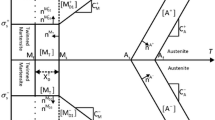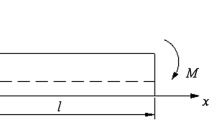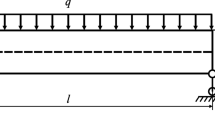Abstract
In this study, the shape memory effect of SMA beams under complex stress conditions is studied by means of a finite element model. The 1D version of a well-established SMA constitutive model is utilized in the numerical computations and the required parameters are obtained experimentally starting from thermal cycling tests in tension under different constant loads. After being calibrated, the model is used to compute the deformation of beams loaded in bending and undergoing thermal cycling; three-point bending and cantilever configurations are considered in this stage. Finally, the response predicted by the model is compared to experimental results and model capabilities are discussed. In particular, insight of the stress and strain evolution in bending is provided.













Similar content being viewed by others
References
J. Arghavani, F. Auricchio, R. Naghdabadi, A. Reali, and S. Sohrabpour, A 3-D Phenomenological Constitutive Model For Shape Memory Alloys Under Multiaxial Loadings, Int. J. Plast., doi:10.1016/j.ijplas.2009.12.003 (2009)
P. Sittner, L. Heller, J. Pilch, P. Sedlak, M. Frost, Y. Chemisky, A. Duval, B. Piotrowski, T. Ben Zineb, E. Patoor, F. Auricchio, S. Morganti, A. Reali, G. Rio, D. Favier, Y. Liu, E. Gibeau, C. Lexcellent, L. Boubakar, D. Hartl, S. Oehler, D.C. Lagoudas, and J. Van Humbeeck, Round Robin SMA Modelling, Proceedings of ESOMAT, Prague, 2009
F. Auricchio, A. Coda, A. Reali, and M. Urbano, SMA Numerical Modeling Versus Experimental Results: Parameter Identification And Model Prediction Capabilities, J. Mater. Eng. Perform., 2009, 18(5), p 649–654
F. Auricchio, A. Reali, and U. Stefanelli, A Macroscopic 1D Model for Shape Memory Alloys Including Asymmetric Behaviors and Transformation-Dependent Elastic Properties, Comput. Methods Appl. Mech. Eng., 2009, 198, p 1631–1637
F. Auricchio and L.A. Petrini, Three Dimensional Model Describing Stress Temperature Induced Solid Phase Transformation: Solution Algorithm and Boundary Value Problems, Int. J. Numeric. Methods Eng., 2004, 61, p 807–836
W. Huang, “Shape Memory Alloys and their Application to Actuators for Deployable Structures,” Dissertation submitted to the University of Cambridge for the degree of Doctor of Philosophy, 1998
L.L. Toia, A. Coda, G. Vergani, L. Fumagalli, and F. Butera, Functional Characterization of SMA Wire in Actuation Conditions, Proceedings of SMS, 2006, p 499–506
O.C. Zienkiewicz and R.L. Taylor, The Finite Element Method for Solid and Structural Mechanics, Elsevier: Butterworth-Heinemann, Oxford, 2005
Author information
Authors and Affiliations
Corresponding author
Additional information
This article is an invited paper selected from presentations at Shape Memory and Superelastic Technologies 2010, held May 16-20, 2010, in Pacific Grove, California, and has been expanded from the original presentation.
Rights and permissions
About this article
Cite this article
Auricchio, F., Morganti, S., Reali, A. et al. Theoretical and Experimental Study of the Shape Memory Effect of Beams in Bending Conditions. J. of Materi Eng and Perform 20, 712–718 (2011). https://doi.org/10.1007/s11665-011-9838-y
Received:
Revised:
Published:
Issue Date:
DOI: https://doi.org/10.1007/s11665-011-9838-y




